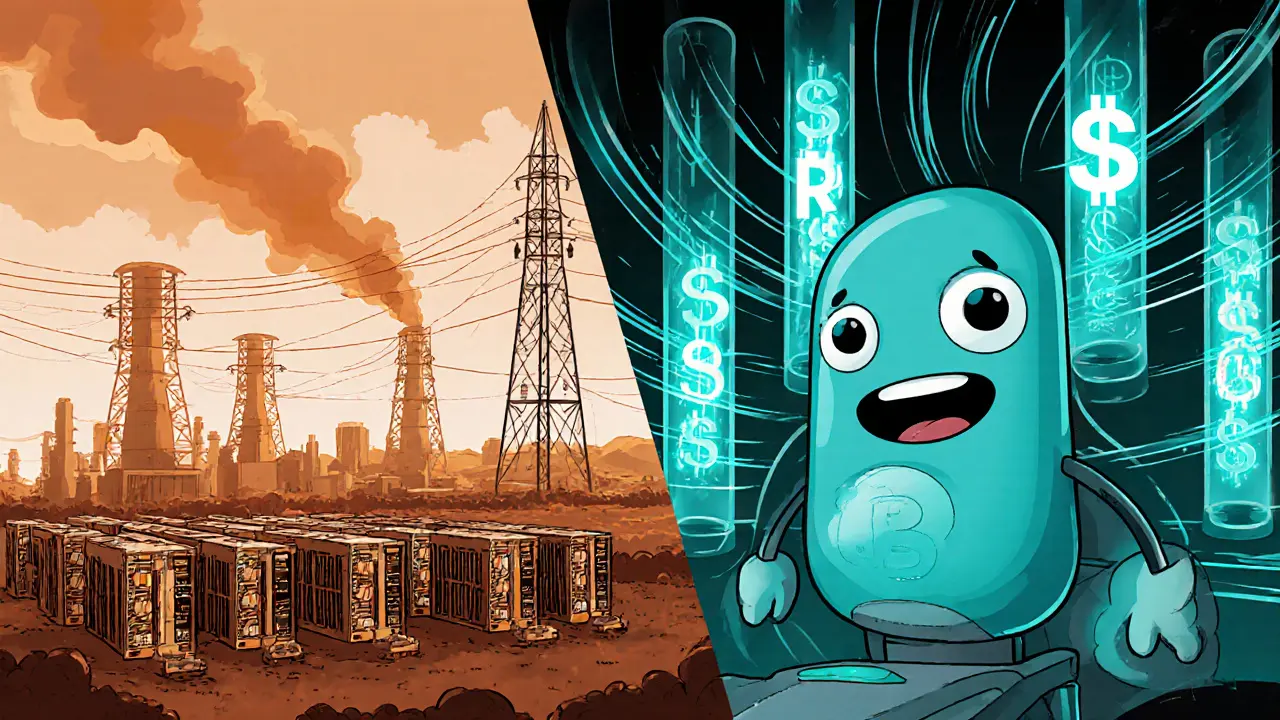Bitcoin Mining Profitability Calculator
Mining Profitability Calculator
Calculate your daily mining profitability based on current market conditions
Results
Daily Revenue:
Daily Electricity Cost:
Daily Profit/Loss:
Based on current market conditions (data as of July 2025)
* Values calculated using industry-standard assumptions
* Data reflects typical conditions for Bitcoin mining in 2025
When people talk about Proof of Work is a decentralized consensus mechanism that secures blockchain networks by requiring miners to solve cryptographic puzzles, they often wonder if it still matters in 2025.
What Exactly Is Proof of Work?
Proof of Work (PoW) asks participants-called miners-to find a hash value that meets a network‑defined difficulty target. The first miner who succeeds broadcasts the solution, and every node independently checks the hash. If the block’s transactions are valid and the hash meets the difficulty, the block is appended to the chain.
The beauty of PoW lies in its reliance on real‑world resources: electricity and specialized hardware. Because an attacker would need to duplicate the entire network’s computational power, the cost of a successful attack becomes prohibitive.
How PoW Secures Bitcoin Today
Bitcoin remains the poster child for PoW. After more than 15 years of continuous operation, the network has never suffered a successful double‑spend attack. In July 2025, Fidelity’s analysis highlighted Bitcoin’s $1.2 trillion market cap and its flawless security record as the primary reason investors still consider it digital gold.
Miners today receive a block reward of 3.125 BTC plus transaction fees, which averaged $3.27 per transaction in Q2 2025. The reward structure aligns incentives: miners earn money only when they keep the ledger honest.
Energy Consumption and Transaction Speed: The Biggest Trade‑offs
PoW’s security comes at a price. The Cambridge Bitcoin Electricity Consumption Index measured the network’s annual draw at roughly 121.72 TWh in early 2025-more than the total electricity use of 150 countries combined. This raises ESG concerns and leads many jurisdictions to impose energy caps on mining operations.
Speed is another pain point. Bitcoin processes 4‑7 transactions per second (TPS), while Visa handles roughly 24,000 TPS. For everyday payments, this latency makes PoW unattractive compared with faster alternatives.

PoW vs PoS: A Side‑by‑Side Look
| Metric | Proof of Work (PoW) | Proof of Stake (PoS) |
|---|---|---|
| Security model | Resource‑intensive mining; attacks require massive hardware and electricity. | Stake‑based validation; attacks need >50% of staked tokens. |
| Energy usage | ~121 TWh / year (Bitcoin) | ~0.01 TWh / year (Ethereum) |
| Transaction throughput | 4‑7 TPS | ~30‑60 TPS (Ethereum) / 65,000 TPS (Solana) |
| Market share (crypto cap) | ~18 % (all PoW chains) | ~70 % (all PoS chains) |
| Average annual reward yield | ~3 % (BTC mining revenue after costs) | ~3.15 % APY (ETH staking) |
The table makes it clear why many developers gravitate toward PoS for new projects: dramatically lower energy footprints and higher throughput. Yet PoW retains a distinct advantage in pure security and censorship resistance.
Real‑World Use Cases That Still Favor PoW
Store‑of‑value assets-most notably Bitcoin-prioritize security over speed. Institutional investors cite the “battle‑tested” nature of PoW when allocating capital to digital gold.
Some niche decentralized applications rely on PoW’s immutable audit trail. For example, certain oracle networks experiment with Bitcoin‑anchored data feeds to benefit from the network’s high cost of tampering.
Hybrid models like Decred blend PoW’s mining with PoS’s voting, offering a compromise that keeps miners in the loop while allowing efficient governance.

Challenges Facing Miners in 2025
Energy costs have risen to an average $0.085 /kWh worldwide for mining rigs, stretching profit margins. HashrateIndex’s Q2 2025 survey revealed that 63 % of Bitcoin miners reduced capacity in the last year.
Regulatory pressure is intensifying. Twenty‑eight countries now enforce explicit caps on mining‑related electricity consumption. Nevertheless, the SEC’s March 2025 clarification that mining activity does not constitute a securities offering removed a major legal uncertainty for U.S. operators.
The hardware barrier has also grown. Modern ASICs such as the Antminer S21 (released Q4 2024) require at least 2.5 MW of power and sophisticated cooling, pushing solo mining out of reach for hobbyists.
Future Outlook: Hybrid and Niche Paths
Gartner predicts PoW will capture only 10‑15 % of the total blockchain market by 2030, mainly in secure, low‑throughput applications. Hybrid consensus mechanisms-combining PoW’s security with PoS’s efficiency-are expected to rise, offering a middle ground.
Proposals like Drivechain (targeted for Q4 2025) aim to attach sidechains to Bitcoin, enabling new functionality while preserving the PoW core. If successful, this could revive interest in PoW‑based layers without sacrificing security.
In summary, PoW is not disappearing overnight; it is reshaping. Its relevance now hinges on whether you need unmatched security (yes) or high speed and low carbon footprint (no). The decision comes down to the specific problem you’re solving.
Frequently Asked Questions
Is Bitcoin still safe because of Proof of Work?
Yes. Bitcoin’s 15‑year track record of zero successful attacks demonstrates that PoW’s resource‑based security remains effective, even as other chains migrate to PoS.
Can PoW become environmentally friendly?
Some projects offset energy use with renewable sources, but the fundamental answer‑finding process is still energy‑intensive. Hybrid models are currently the more realistic path to lower emissions.
Will PoW disappear after 2025?
No. PoW will likely persist in niche areas where maximum security is non‑negotiable, such as Bitcoin’s store‑of‑value role and specialized oracle layers.
How does PoS beat PoW on speed?
PoS replaces costly hash calculations with a simple stake‑weight check, allowing thousands of transactions per second without the energy overhead of mining.
What are the biggest risks for new PoW miners?
Rising electricity prices, regulatory caps, and the need for industrial‑scale ASIC hardware are the top hurdles faced by miners entering the market in 2025.

8 Comments
Derajanique Mckinney
poW is sooo last decade 😴 why are we still talking about this like it's 2017? energy waste = bad, period. 🤷♀️
Kirsten McCallum
Security isn't a feature. It's the foundation. You don't trade your soul for speed.
Henry Gómez Lascarro
Look, I get it, you're all obsessed with greenwashing crypto now, but let's be real-PoS is just centralized voting with extra steps. The moment you rely on stake instead of real-world cost, you're trusting rich people to be honest. And guess what? Rich people don't care about decentralization. They care about control. Bitcoin's PoW isn't just a consensus mechanism-it's a social contract written in electricity and silicon. Every watt burned is a bullet in the armor against tyranny. PoS chains? They're basically Wall Street with a blockchain logo. And don't even get me started on Solana's 65k TPS-how many times has it gone down this year? Five? Six? Meanwhile, Bitcoin's been running nonstop since 2009. You want efficiency? Fine. But don't call it security. That's just marketing jargon for 'I'm too lazy to understand cryptography.'
Lawrence rajini
PoW still matters for the same reason we still have gold reserves 💪💰 the world needs something that can't be turned off or manipulated. keep it alive!
Matt Zara
Honestly, both sides have valid points. PoW is like a fortress-expensive to build, impossible to break. PoS is like a gated community-cheaper to run, but someone’s got the keys. Maybe the future isn’t choosing one over the other but letting each serve its purpose. Bitcoin stays PoW for security. New apps use PoS for speed. No need to hate.
Frech Patz
The energy consumption figures are misleading. A significant portion of Bitcoin mining now utilizes stranded, flared, or otherwise wasted energy sources-particularly in regions with surplus hydro, wind, or natural gas that would otherwise be vented. This isn't just 'power usage'-it's energy recycling at scale. Moreover, the economic incentive structure ensures that miners optimize for efficiency, driving innovation in cooling, chip design, and grid integration. The notion that PoW is inherently wasteful ignores the market forces that make it dynamically efficient.
Jean Manel
You think Bitcoin's 'security' is real? It's just a pyramid scheme with more math. The only thing harder than attacking it is making a profit mining it. 63% of miners shut down last year. That's not resilience-that's a dying industry clinging to nostalgia. And you call that 'digital gold'? More like digital tulips with ASICs.
Will Barnwell
lol the 'battle-tested' argument is so tired. So was the horse and buggy. Just because something hasn't broken yet doesn't mean it's not obsolete. PoS is faster, cheaper, and more scalable. Bitcoin's stuck in 2012 while the rest of the world moved on. The only people still defending PoW are miners who can't afford new hardware and degens who think 'decentralization' means 'I don't have to learn anything new.'